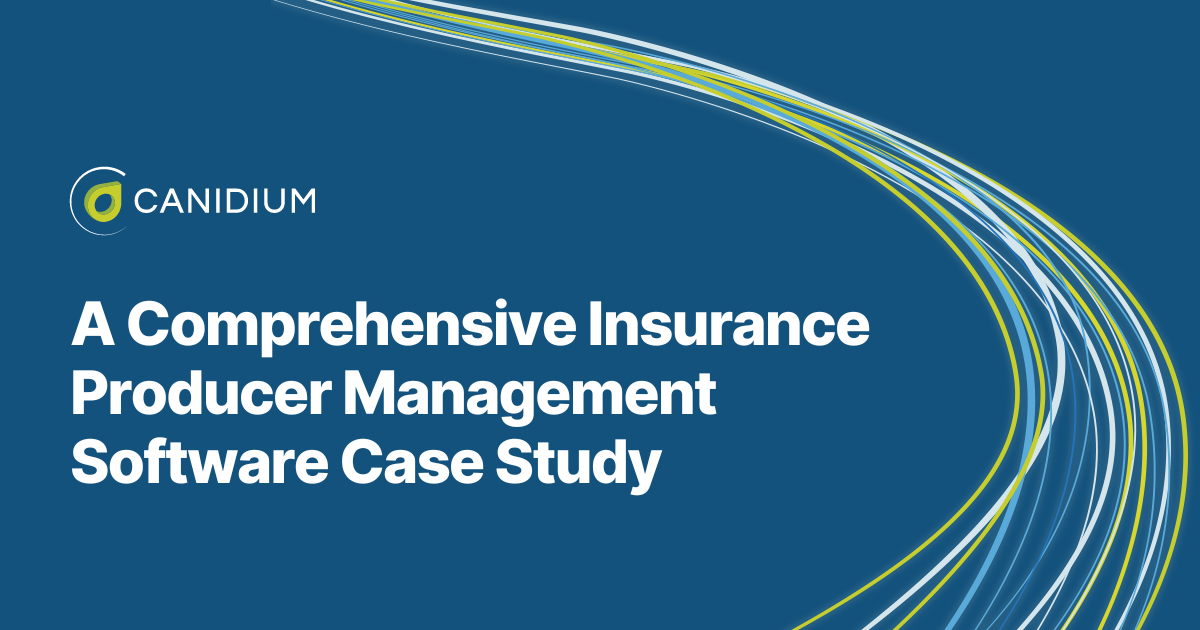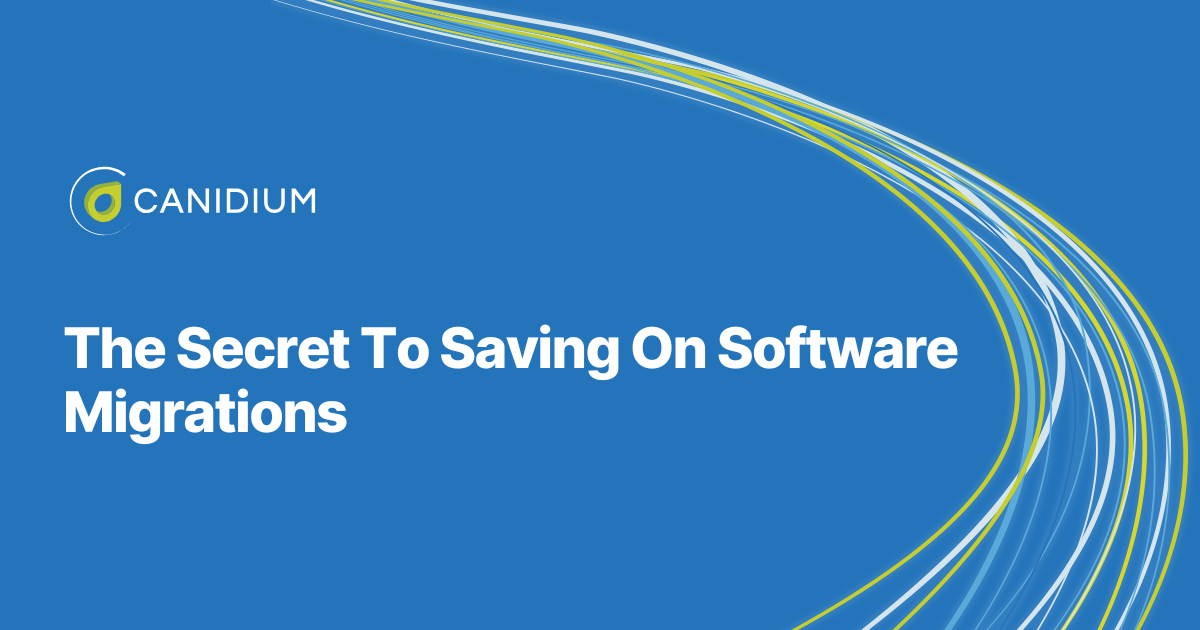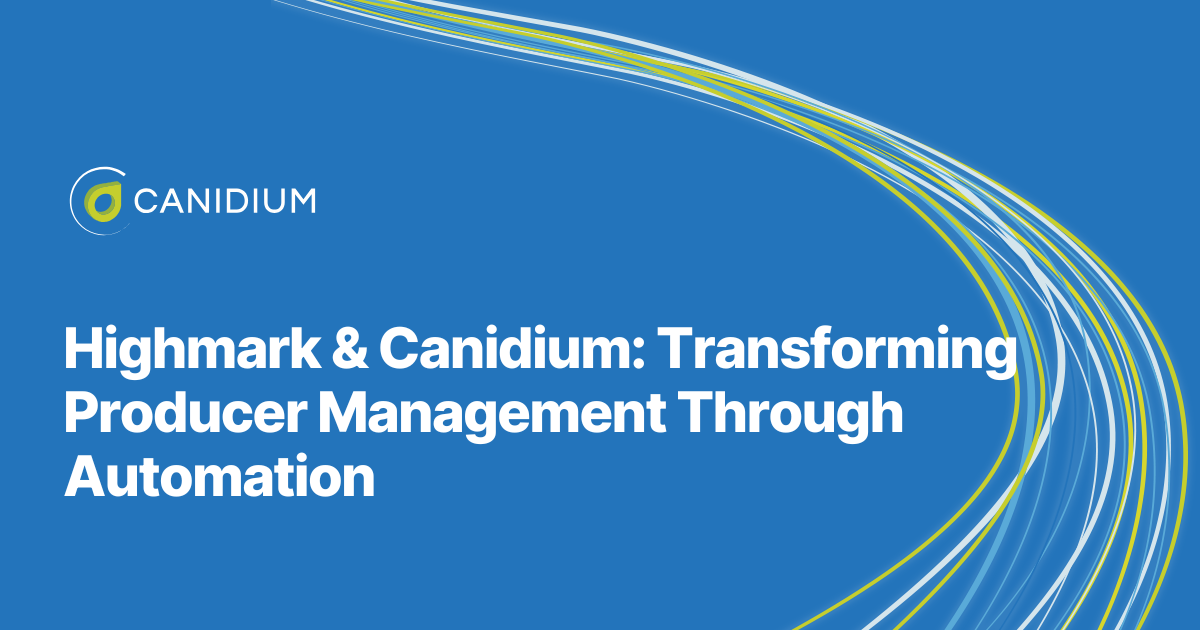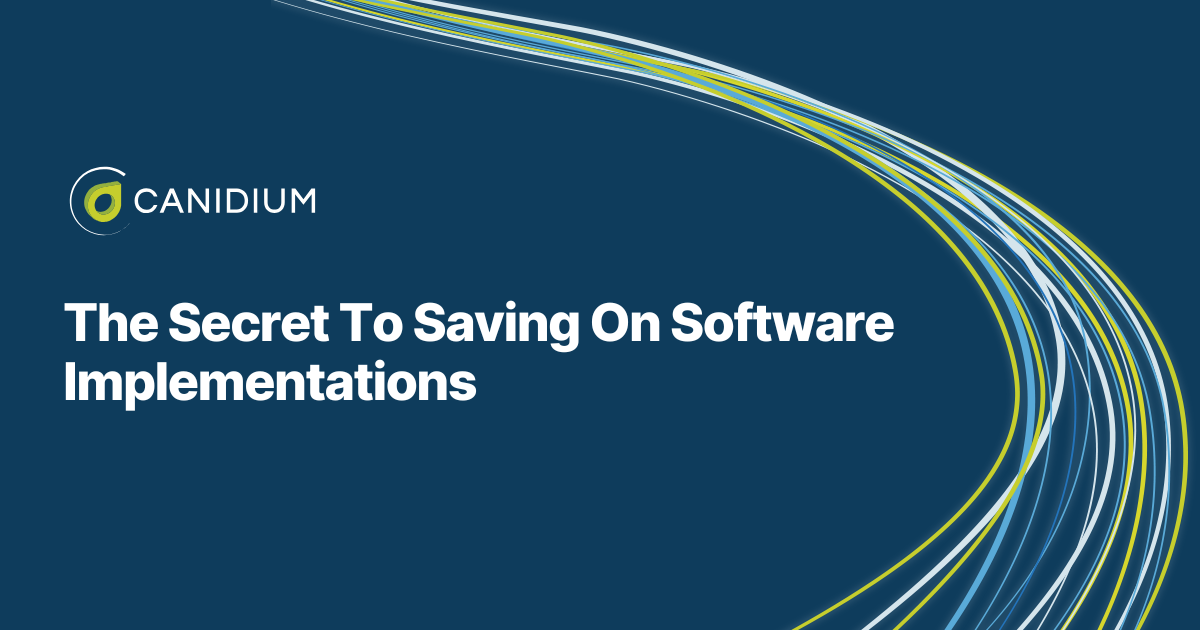Insurance companies often face significant challenges due to data fragmentation across various systems and departments, leading to inconsistencies, compliance issues, and commission processing inefficiencies. These data silos can impact nearly every aspect of operations, hampering agent performance, reducing efficiency, hindering data-driven decision-making, and increasing processing errors.
At Canidium, our team of insurance producer management software experts designs, configures, and implements solutions to IT infrastructure challenges.
This comprehensive case study explores the implementation of insurance producer management software to overcome these barriers. Then, by examining how Canidium's implementation team leveraged the APM Datastore to address these challenges, this study provides valuable insights into the transformative impact of a unified, integrated producer management solution on policy administration, compliance, and overall operational efficiency in the insurance industry.
Case Study Findings: 5 Barriers to Improving Agent Performance for Insurance Carriers
Insurance companies often face challenges managing producer data across various systems and departments. The consequences of data silos can impact nearly every aspect of operations: hampering agent performance, reducing efficiency, hindering data-driven decision-making, and increasing processing errors. Solving these problems is of paramount importance for insurance carriers. However, to come up with targeted solutions, you first need to understand where the pain points in your IT infrastructure are.
Our case study identified five critical technical barriers that insurance producers face:

Data Fragmentation and Integration Issues
Data fragmentation is a pervasive issue in the insurance industry. Poor data quality costs businesses an average of $12.9 million annually. In this case study, the producer data was scattered across different departments, each using its system, such as Excel spreadsheets and Access databases. The difficulty in integrating these various data sources and systems hampered data accessibility and operational efficiency.
The insurance producer found that each department's data had to be manually consolidated, creating significant errors and inefficiencies. The solution implemented a centralized data management system to integrate information from various sources, thereby improving accessibility and streamlining operations.
Compliance and Audit Challenges
One in five surveyed insurance carriers report that their data management governance process is "ineffective." Simultaneously, one in four were neutral on the question. Based on the one-on-one interviews survey Deloitte's takers conducted, they are able to theorize on the impetus for widespread dissatisfaction with regulatory compliance processes. Insurance producers cited limited holistic data governance and misaligned data pipelines.
"For example, the rapid influx of data from both internal and external sources is unlikely to deliver full value as long as information is stored in siloed and often incompatible legacy systems—making it tough to share, let alone scale for optimum value." -Deloitte, How to walk the talk by treating insurer data as a strategic asset.
In this case study, a key issue was the lack of a unified system, which hindered the maintenance of historical records and audit trails, posing compliance risks. The rapid influx of data from both internal and external sources did not deliver full value because information was stored in siloed and often incompatible legacy systems. This made it tough to share data, let alone scale it for optimum value.
The insurance company addressed these compliance challenges by implementing a unified data management system that maintained comprehensive historical records and audit trails. This system ensured that all data was stored in a centralized location, making it easier to access and review all information from a single source during audits, thus significantly reducing compliance risks.
Multiple Hierarchies and Policy Management
Managing multiple hierarchies and ensuring the correct hierarchy usage for given scenarios is complex. This complexity often leads to errors and inefficiencies in policy management.
For instance, the insurance carrier in this case study struggled to manage the hierarchical structure of its producers, which varied depending on the type of policy and the producer's role. This complexity was exacerbated by using different systems for different types of policies. By implementing a centralized producer management system, the company was able to standardize the hierarchy management process, including updating the producer of record and making book of business moves, ensuring consistent and accurate policy management across all departments.
Homegrown Systems
Many insurance companies rely on outdated, homegrown systems that are difficult to maintain and integrate with modern solutions. While digital transformation spending is projected to reach $3.9 trillion in 2027, an estimated 31% of organization technology is still comprised of legacy systems.
In this case study, the insurance company was using several homegrown systems that were not only outdated but also incompatible with each other. This incompatibility made it challenging to share data and integrate new technologies. The company replaced these homegrown systems with a modern, integrated producer management solution. This transition improved data integration and enhanced system maintainability and scalability.
Data Integrity Without a Centralized Platform
Without a centralized platform, ensuring data consistency and integrity across various departments and systems is challenging. The insurance company's reliance on multiple disparate systems resulted in data inconsistencies and integrity issues.
For example, different departments often had conflicting information about the same producer, leading to confusion and errors. By implementing a centralized producer and commissions management platform, the company ensured that all departments had access to the same, up-to-date information. This centralized approach significantly improved data consistency and integrity.
Most carriers don’t have a single source of truth for Producer data, further exacerbating these issues. By implementing a centralized Producer datastore, the carrier ensured that all departments had access to the same, up-to-date information. This centralized approach significantly improved data consistency and integrity.
Infrastructure Solutions: What is Insurance Producer Management Software?
Software designed specifically for insurance producer management, such as SAP's Agent Performance Management (APM) Datastore, consolidates information from various departments and systems into a single, easily accessible platform.
APM ensures data accuracy and consistency across the organization. It consolidates data from various sources into one unified system, allowing for real-time updates and accurate data sharing across all departments. This not only resolves conflicting information but also streamlines processes, reduces errors, and enhances overall efficiency in managing producer and commissions data. Essentially, it creates a single source of truth for insurance producers.
This unified approach simplifies compliance with regulatory requirements. It enhances operational efficiency by streamlining daily workflows such as commission processing and reporting. At the same time, APM implementations help insurance companies overcome data fragmentation, outdated systems, and integration issues. It is a robust, scalable solution that supports the evolving needs of the insurance industry, delivering significant cost savings and operational improvements.
The key features of APM as a datastore include comprehensive producer management, which allows for the efficient handling of internal and external producers, regardless of their hierarchical complexity. Payee relationships are also seamlessly managed, ensuring accurate and timely commission processing. At the same time, APM includes robust compliance features, helping insurance companies adhere to regulatory requirements by maintaining comprehensive records and audit trails. Finally, integration capabilities allow APM to work seamlessly with other systems, enhancing overall operational efficiency.
Implementing APM: How Leveraging Producer Management Applications Improve Policy Administration
Insurance carriers often manage vast networks of producers, each with unique data points, commission structures, and compliance requirements. Most insurers, including internal employees, independent agents, and agencies, manage a sprawling sales force. This presents numerous challenges, from data fragmentation and integration issues to maintaining regulatory compliance and managing complex commission structures.
Imagine an insurance company that operates across multiple regions, offering a diverse range of insurance products such as life, auto, and property insurance. Say the sales network includes around 100,000 producers, a mix of direct employees, and independent agents. Each producer operates within different hierarchies, has various commission agreements, and must comply with many state and federal regulations.
In this scenario, the insurance company will likely encounter all five critical IT infrastructure barriers discussed above. In this case study, Canidium's implementation team leveraged APM datastore to resolve our client's challenges.
.png?width=1920&height=1080&name=Map%20Your%20Pricing%20Structure%20(1).png)
Consolidating Insurance Producer Data
Canidium's implementation team leveraged the APM datastore to resolve the challenges faced by the client. The tool was configured and implemented to consolidate producer data from different departments and systems into one centralized location. Data silos were eliminated as a result of APM's implementation, making it easier to manage and access critical producer information.
With all producer data in a single, unified platform, the company can streamline onboarding, credentialing, and performance tracking processes, leading to improved productivity and reduced administrative burden.
Ensuring Compliance With Regulatory Requirements
APM addresses compliance challenges by implementing audit trails and maintaining historical data. These features support regulatory requirements, ensuring all producer activities are documented and easily accessible for audits. This reduces non-compliance risk and helps the insurance company avoid potential fines and penalties.
The system's robust compliance tools ensure that producers meet all necessary licensing and continuing education requirements, which is critical in an industry where regulatory standards are stringent and constantly evolving. Cainidium leveraged the tool to automate compliance tracking and reporting for the client. As a result, APM minimized the administrative workload and ensured adherence to all relevant regulations.
Facilitating Integration to Improve Producer Management Processes
According to surveyed business leaders, two-thirds use data every day. However, 78% of respondents said using their data is a challenge, and over one-third said they are not using it to make decisions.
Canidium used REST APIs to integrate APM with other critical systems, ensuring easy data access and management. By integrating APM, the insurance company could better leverage its data for strategic decision-making and operational efficiency. This seamless integration enables real-time data sharing and enhances department collaboration, leading to more informed decision-making and improved overall performance.
Case Study Results: What Impact Does Producer Management Software Have?
Implementing producer management software, such as APM, has demonstrated significant positive impacts on insurance companies. These benefits span various aspects of their operations, from data accuracy and compliance to operational efficiency and cost savings.
.png?width=1920&height=1080&name=Map%20Your%20Pricing%20Structure%20(2).png)
- Improved Data Accuracy: Data accuracy was one of the most notable improvements observed. With APM consolidating data from multiple departments and systems into a single platform, inconsistencies and errors in producer information were significantly reduced. This centralization ensures that all data is up-to-date and uniform across the organization, facilitating better decision-making and reducing the administrative burden of correcting errors.
- Enhanced Compliance: Compliance is a critical concern for insurance companies, and APM has proven instrumental in this area. The software's comprehensive audit trails and historical data maintenance streamline audit processes and ensure regulatory compliance. With all producer activities documented and easily accessible, the risk of non-compliance is minimized, protecting the company from potential fines and legal issues.
- Operational Efficiency: The introduction of APM has led to marked improvements in operational efficiency. Commission processing, which previously involved time-consuming manual calculations and reconciliations, is now faster and more accurate. This automation speeds up payment cycles and enhances accuracy, reducing disputes and increasing producer satisfaction. The streamlined agency workflows and improved distribution management allow staff to focus on more strategic tasks, further boosting productivity.
- Cost Savings: A study by the Government Accountability Office (GAO) found that just ten legacy systems cost the government $337 million yearly. More specifically, banks and insurance carriers dedicate 75% of their IT budgets to maintaining legacy systems. The financial benefits of APM are substantial. APM provides a more comprehensive and cost-effective solution by eliminating the need for multiple disparate systems and reducing the maintenance costs associated with legacy software.
Key Takeaways: What Does This Case Study Tell Us About Insurance Producer Management Software?
This case study underscores the pivotal role that insurance producer management software, like SAP APM implemented by Canidium, plays in transforming operational efficiency and accuracy within insurance companies. One of the key takeaways is the importance of consolidating producer data into a unified system. This centralization significantly improves data accuracy and streamlines various business processes, enhancing overall operational efficiency. Furthermore, the compliance benefits are substantial; maintaining historical values and comprehensive audit trails ensures that regulatory requirements are easily met, thereby reducing the risk of fines and legal issues.
The integration capabilities of such software are equally crucial. APM's ability to seamlessly integrate with other systems enhances data accessibility. It supports a range of business operations, facilitating better decision-making and operational fluidity. Replacing outdated, homegrown systems with a standardized solution like APM leads to significant cost savings. This transition reduces the financial burden of maintaining multiple disparate systems. It allows for the reallocation of IT budgets towards more strategic initiatives.
Adopting an advanced insurance producer management system is not merely a technological upgrade but a strategic imperative that drives efficiency, compliance, and cost-effectiveness, positioning insurance companies for sustained success in a competitive market. To round out your understanding of the potential solutions to insurance agency management challenges, learn more about APM here.








